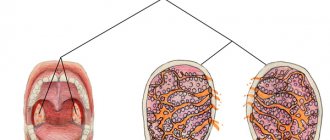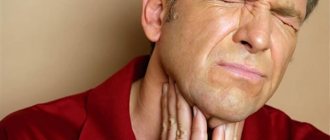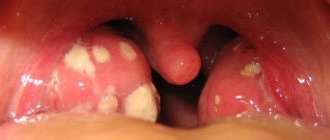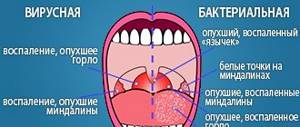Indications for tonsil removal
Surgery to remove tonsils in patients with chronic tonsillitis becomes mandatory in the following cases:
- With frequent exacerbations (more than 4 episodes over one year), low effectiveness of conservative therapy.
- In case of constant accumulation of purulent masses in the lacunae and tissues of the tonsils.
- With weakened immune defense caused by the inability of the tonsils to protect the body from infections.
- With the development of complications of tonsillitis, spreading to various organs and parts of the body (kidneys, cardiovascular system, musculoskeletal system).
- In cases of a significant increase in the size of the tonsils, leading to an increased risk of breathing problems, the occurrence of abscesses and purulent inflammation in the tonsils, larynx, nasopharynx, upper respiratory tract.
Surgical treatment is recommended for patients in whom the chronic form of tonsillitis leads to a significant deterioration in the quality of life, chronic fatigue, decreased performance, and fatigue.
During the operation, one of two methods is used - tonsillotomy or tonsillectomy. In the first case, only the affected areas of the tonsils are subject to removal. Tonsillectomy involves the complete removal of the tonsils, including the connective tissue capsule.
Why does tonsillitis occur: routes of transmission
The cause of tonsillitis in humans is most often microbes, sometimes viruses lead to it. In most cases, it is caused by streptococci , which contribute to complications. With it, the risk that the disease will become chronic increases significantly. Therefore, before treatment with antibiotics, if you have been diagnosed with a sore throat, it is important to identify the pathogen by taking a throat swab.
What does bacterial and viral tonsillitis look like?
The disease, or rather pathogenic microorganisms, is transmitted by airborne droplets from a sick person to a healthy one. However, doctors say that often a sore throat is an exacerbation of chronic tonsillitis, which a person already has. This process occurs when an infectious pathogen is activated, which is located in the lacunae of the tonsils.
Not only untreated tonsillitis causes chronic tonsillitis. Chronic tonsillitis can also be caused by:
- the presence of infectious foci in the body (pharyngitis, rhinitis, sinusitis, caries, etc.),
- frequent respiratory diseases,
- immunodeficiency states.
Symptoms of acute tonsillitis
Often people may confuse a sore throat with an acute respiratory infection, which is accompanied by a sore throat. With a sore throat, the tonsils themselves turn red, plugs and purulent plaque appear on the tonsils, and with ARI, the patient’s entire throat turns red, and he experiences a diffuse sore throat.
In addition, the acute form of tonsillitis is characterized by the following symptoms: general weakness, sore throat (especially when swallowing), enlarged lymph nodes, high body temperature (up to 39-40 degrees), headache. A blood test will show the inflammatory process in the body (an increase in the number of leukocytes and ESR).
Symptoms of chronic tonsillitis
Chronic tonsillitis is characterized by a wave-like course of the disease - periods of remission alternate with periods of exacerbations. Most often, patients complain of recurring sore throats, periodic pain when swallowing, bad breath, plugs in the tonsils, including purulent ones. Low-grade fever (37.1-38 degrees) may be present for a long time
If a person has been suffering from chronic tonsillitis for a long time, over time he will develop purulent foci in the tonsils. caseous plugs are increasingly appearing - this is an accumulation of food, microbes, leukocytes - due to which a person has an extremely unpleasant odor from the mouth, and when swallowing he feels discomfort. As a result, conditions are created in the tonsils for the proliferation of pathogenic microbes, which do not allow the inflammatory process to stop.
Chronic tonsillitis is also indicated by scars on the tonsils, redness and thickening of the edges of the palatine arches. If you press on the lacunae, creamy pus may ooze out.
This is what plugs in the tonsils look like
It is worth noting that there are two forms of chronic tonsillitis. There is a compensated form, when there are already changes in a person’s tonsils, but the main function - protecting the body - has not yet been affected. And there is also a decompensated form, in which the patient develops general intoxication and the tonsils stop “working.”
How to cure tonsillitis without removing tonsils
An otolaryngologist treats tonsillitis. For acute tonsillitis, antibiotics and antiseptic, anti-inflammatory drugs, for example, hexaspray or stopangin, are prescribed.
Chronic tonsillitis is more difficult to cope with. If the disease is compensated, conservative treatment is carried out. But if decompensation and complications develop, surgical intervention may be necessary.
In the first case, the patient is prescribed procedures that are aimed at correcting immunity, improving drainage of the tonsils and combating pathogenic microflora in the lacunae. They are usually held twice a year. These are rinsing with medicinal solutions and removing plugs, lubricating the mucous membranes of the tonsils with an antiseptic, gargling (Chlorhexidine, Furacilin, herbal decoction), taking immunomodulators, physiotherapy (electrophoresis, etc.). Antibiotics (Amoxiclav, Bioparox) are prescribed only during exacerbation of the disease. To consolidate the results after treatment, it is recommended to go to the sea for a couple of weeks in regions with a dry climate.
This treatment is carried out if the patient complains only of a blockage in the throat, has not been previously treated and surgery is not yet required. You should be prepared for the fact that conservative treatment of tonsillitis may take several years.
Frequent sore throats, the development of complications (heart disease, joint diseases, exacerbation of pyelonephritis, etc., peritonsillar abscess, conservative treatment did not bring any effect - these are indications for surgical treatment.
How to remove tonsils with a laser and scalpel
Removal of the tonsils (tonsillectomy) is performed using a scalpel (most often) and a laser. Laser tonsil removal, according to reviews from people who have undergone this operation, is a better method compared to cutting out the tonsils with a scalpel. The advantage of using a laser is that only the affected areas of the tonsils can be removed, there is no bleeding.
First, the patient will be given anesthesia, and then the most important thing comes: the doctor grabs the tonsil with forceps and slowly peels it off with a laser beam. The operation lasts on average 30 minutes and does not require going to the hospital. There are also disadvantages:
- when removing tonsils with a laser, healthy areas of the oral cavity can be burned;
- high cost of the procedure.
When removing tonsils with a scalpel, a person will experience blood loss and mental anguish (according to the patients themselves, this operation is not for the faint of heart, and the recovery period is quite painful). The surgeon makes an incision and everts the tonsil pelvis, cuts off the stalk and removes the tissue. In this case, local or general anesthesia is used. The procedure takes from one to two hours. Hospitalization in a hospital is mandatory.
Here are some reviews about tonsil removal:
“They sat me down on a chair, gave me an iron tray and began. The surgeon sprayed it in the mouth several times, and there was a feeling of a lump in the throat. Then I injected several times into one gland, it didn’t hurt at all, it just felt like something was being pierced. And he started doing something in his mouth there. I sat with my eyes closed, initially I decided that I wouldn’t watch. When there were no instruments in my mouth, I spat into the tray. Then they did the same with the other tonsil. At some point, I began to feel a little pain, made a sound, the doctor injected me with another painkiller and continued. As the doctor finished, I opened my eyes to look at my torn out tonsils. All this did not last long, I think 15-20 minutes. Then they carefully placed me on a gurney and took me to the ward.”
Tonsil removal before and after (photo)
Tonsil removal is not performed:
- during menstruation,
- pregnancy,
- if a person has active tuberculosis,
- diabetes mellitus,
- acute viral diseases,
- infectious diseases,
- in case of renal failure,
- if you have heart problems,
- blood clotting is impaired.
It is performed only when the tonsils are not inflamed.
Is it necessary to remove tonsils for chronic tonsillitis - expert opinion
There is a widespread belief that after the tonsils are removed, pathogenic bacteria will freely enter the human body. There is some truth in this statement, but tonsillectomy is often the only way to avoid the development of serious complications.
Many experts explain that the adult body has other immune mechanisms that can protect it from infections. And constantly inflamed tonsils are not able to perform their main function and become a source of inflammation and pathological processes.
Carrying out the operation at the appropriate level and the patient’s conscientious attitude towards going through the recovery stage in most cases become a guarantee of complete relief from pathology and a full life without constant exacerbations of the disease.
How to prepare for surgery
Removal of tonsils (resection) is a full-fledged operation, and therefore a detailed examination of the patient is carried out before surgery. The following are required to be shown:
- blood donation for RW, necessary to identify the Rh factor and group;
- general urine analysis;
- throat swab to determine microflora and sensitivity to antibiotics;
- biochemical blood test, which serves to clarify the level of cholesterol, bilirubin, urea, etc.;
- coagulogram;
- cardiogram.
Additionally, fluorography of the lungs may be prescribed. The final stage of preparation for resection is the examination of laboratory results by the therapist and a detailed consultation.
A month before the planned operation, the patient must stop taking certain medications. During the week preceding surgery, you will need to take medications that improve blood clotting.
On the day of tonsillectomy, you are prohibited from eating or drinking. If a patient requiring surgical treatment has her period, the procedure is canceled before it is completed.
How tonsils are removed - types of operations
The traditional method of removing tonsils is to use a wire loop and surgical scissors. This operation is painful and traumatic, can cause bleeding, requires general anesthesia, and therefore is used quite rarely.
In modern medicine, the following methods are used to perform tonsillotomy and tonsillectomy:
- Cryodestruction, which consists of using liquid nitrogen to freeze and kill damaged tissue. This method is low-traumatic and allows you to preserve healthy parts of the tonsils, which are responsible for the production of immune cells, providing local immunity and protection against the penetration of pathogenic microflora into the body. To completely remove the tonsils, repeated procedures are often required.
- Laser treatment, which allows you to simultaneously remove damaged areas of the tonsils and cauterize the vessels, thus minimizing the risk of bleeding. The method is known as low-traumatic and does not require long-term rehabilitation.
- Electrocoagulation is the use of high-frequency electric current, which ensures the removal of diseased tonsils with a low risk of developing hemorrhage. Many experts consider this method as undesirable due to the high likelihood of postoperative consequences caused by the effects of electricity on healthy tissue adjacent to the tonsils.
- Ultrasound, which performs surgical actions using ultrasonic vibrations and a special scalpel. During this operation, blood clotting occurs, so there is no risk of significant blood loss.
- The use of a microdebrider - a technology consisting of the use of a special tool with rotating blades. This technique is considered gentle and is used for incomplete removal of tonsil tissue.
Some clinics use radiofrequency ablation and bipolar radiofrequency ablation to remove tonsils. The first method is to use monopolar radiofrequency energy. Turning into heat, it causes the destruction of diseased areas. As a result, the tonsil tissue gradually scars and decreases in size. Bipolar radiofrequency ablation is based on the conversion of radiofrequency exposure and the formation of an ionized layer that destroys molecular bonds without the influence of heat.
As a result of this treatment, the tonsils are not completely removed, but only reduced in size. Radiofrequency ablation is preferred if enlarged tonsils interfere with a person's ability to swallow or cause sleep apnea .
Manipulations are performed under local anesthesia. During the procedure, a probe is inserted into the tonsil tissue through which radio wave radiation is applied. The main advantage of both methods is ease of implementation, minimal discomfort for the patient and no need to stay in the hospital for several days. Treatment with radiofrequency ablation is considered an outpatient method - soon after the operation, the patient is allowed to leave the medical facility and return to everyday activities.
How is the operation performed?
The operation to remove tonsils is carried out in several stages
- anesthesia - general or local anesthesia, the choice of which is determined by the anesthesiologist, taking into account the individual characteristics of the patient;
- direct removal of tonsils, which takes from 30 to 45 minutes;
- completion of the anesthesia.
After the operation, the patient remains in the clinic for some time under the supervision of medical staff. Most often, hospital stay lasts from 3 to 5 days. In some cases it may take up to 7-10 days.
Complications of surgery include the possibility of bleeding or infection, and allergic reactions to drugs used as painkillers (anesthetics). Before surgery, persons predisposed to allergies are prescribed a course of antihistamines.
Serious consequences of anesthesia after tonsillectomy are extremely rare - in 1 patient out of 10,000. The probability of death is 1 in 250,000 operations.
Postoperative care
After the operation, the patient is observed in the hospital to prevent complications (reactions to anesthesia, bleeding). At home, you should follow your doctor’s recommendations to ensure the recovery process goes smoothly:
- take medications as prescribed;
- For a week, adhere to the voice mode (do not talk for a long time), avoid coughing;
- drink plenty of fluids;
- food should be easily digestible, not spicy, not salty;
- For the first 3-4 days, soft food is preferable;
- avoid “scratching” hard foods (cookies);
- normal water procedures.
You should seek the help of a doctor if you are concerned about any of the following signs:
- infection, with fever, chills;
- the surgical site is red, swollen, very painful, bleeding or discharge appears;
- nausea (possible vomiting) does not go away for more than 2 days;
- pain that does not subside after pain relief;
- cough, shortness of breath, chest pain;
- vomiting, traces of blood in saliva;
- other debilitating complications.
Postoperative period
After the tonsils or part of them are cut out, tissue restoration occurs within 1-3 weeks. During this period, you will need to follow the following medical recommendations:
- on the first day after the operation, do not eat anything, drink only still water;
- further include in the diet predominantly liquid, non-aggressive foods (porridge, pureed meat and vegetables, low-fat soups, yoghurts);
- Avoid eating hot foods and drinks (you should take food slightly warm);
- drink enough clean water;
- stop smoking, visiting baths, saunas, solariums;
- ensure vocal rest, minimal physical activity;
- take a cool shower.
In case of severe pain, it is permissible to take Paracetamol or products based on it. Prohibited drugs include Aspirin and Ibuprofen - after tonsil surgery, these medications can cause bleeding.
It will take at least one week for the postoperative wound to heal. If tissue restoration is not observed during this period, you should consult a specialist.
How does the postoperative period proceed?
After tonsillectomy, wound surfaces remain at the attachment sites of the tonsils. To avoid infection, proper oral care is necessary. This is very important, regardless of how the tonsillectomy was performed. The postoperative period lasts 2-3 weeks. On the first day, it is not recommended to eat or swallow saliva. During sleep, the patient should lie on his side to prevent blood from entering the respiratory tract. 2-3 days after the operation, the wound surface becomes covered with a yellowish coating, low-grade fever is observed, and pain when swallowing intensifies. This is a normal reaction of the body. Surfaces are cleared of plaque after about 10 days. Complete healing is observed by the end of 3 weeks after surgery. Until this time, you should refrain from taking cold or hot food or liquids.
Contraindications to tonsillectomy
Surgery to remove tonsils is not performed in the following cases:
- for cardiovascular diseases (hypertension, tachycardia, angina);
- in patients with tuberculosis, diabetes mellitus, hemophilia, blood diseases, severe anemia;
- with exacerbation of chronic inflammatory diseases of internal organs, the presence of cancer;
- in the last trimester of pregnancy;
- with positive HIV status.
If the patient has mental illness, surgery can only be performed under general anesthesia.
Methods of performing tonsillectomy
As a rule, the tonsils are removed under general anesthesia, but in some cases the doctor is forced to resort to local anesthesia. In addition to classical surgery, tonsellectomy can be performed using other, more effective methods.
- Extomy using a microdebrider. The operation is performed according to the classical technique, but at the same time it causes much less pain to the patient, and therefore can be performed without general anesthesia.
- Tonsillectomy using laser equipment. Unlike other surgical methods, laser removal of tonsils is quick and safe. Quite often, only local anesthesia is used. The great advantage of laser equipment is minimal tissue trauma and sintering of blood vessels, which completely eliminates bleeding. In addition, laser removal of tonsils can be partial.
- Coblation or liquid plasma method. The procedure is quite effective, but its result depends on the skills of the doctor. Coblation involves the use of a cold plasma device, which allows you to carefully remove the tonsils without bleeding. The rehabilitation period passes quickly, and the patient does not feel severe pain.
- Cryodestruction. The technique is based on freezing lymphoid tissue with liquid nitrogen, after which it dies. The procedure is performed under local anesthesia, because... Due to freezing, pain receptors are blocked. The recovery period is quite painful, and repeated cryodestruction is often required.
- Tonsellectomy using an ultrasonic scalpel. The equipment operates at a frequency exceeding 20,000 kHz, and during the operation the tissue is heated to 80°C. The only drawback of the method is the risk of burns on the mucous membrane.
What kind of surgery to remove the tonsils in adults and children should be determined solely by the doctor.
Can you have a sore throat if your tonsils are removed?
Contrary to what was once believed, removal is not a remedy that 100% helps with sore throat. As you know, healthy tonsils inhibit the penetration of infection into the body, prevent the development of ENT diseases and other pathologies. Their absence often leads to the development of various forms of sore throat:
- Catarrhal.
- Follicular.
- Lacunarna.
- Herpetic.
- Fibrinous, etc.
In the absence of tonsils, the treatment of sore throats becomes much more complicated, and traditional medicine often turns out to be powerless. In most cases, strong antibiotics, antiseptics and anti-inflammatory drugs are used to treat patients who have undergone tonsillectomy.
The absence of tonsils also reduces the degree of respiratory protection. This can lead to frequent bronchitis, pneumonia, and other diseases of the upper and lower respiratory tract. That is why most experts insist that tonsils must be treated efficiently and strive to be preserved using all existing methods. Unlike the medical practice of past years, modern doctors try to resort to removing the tonsils only in extreme cases.











